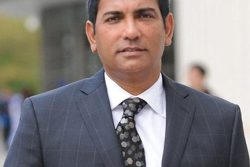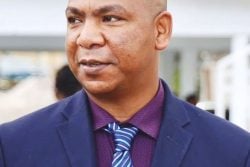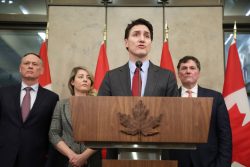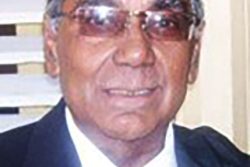The APNU+AFC coalition has taken an important initiative towards transforming Guyana’s culture of ethno-political dominance. In a report in SN on September 6 Prime Minister Nagamootoo, at a meeting in Whim, Corentyne, said “we are prepared to open the doors to the PPP if they want to enter this government.” No further details were given but Minister Raphael Trotman subsequently announced that a team consisting of Prime Minister Nagamootoo, Vice President Greenidge, himself, Minister Ramjattan, Attorney General Basil Williams and Minister Harmon would conduct the negotiations. If the Prime Minister’s statement is a considered policy of serious intent, as it seems, it is expected to be followed by a more formal invitation by President Granger to Leader of the Opposition Bharrat Jagdeo.
The decision by the APNU+AFC coalition to invite the PPP to share the government is a major and welcome departure from earlier positions. While it is true that President Granger had indicated support for a national unity government involving the PPP at the time of President Carter’s visit, most of his public pronouncements had projected the APNU+AFC alliance as the multi-ethnic government of national unity. The reality, of course, is that only an alliance of the two major political parties can be considered as the foundation for national unity.
In 1977 the PPP’s announcement of its National Patriotic Front proposals designed to end ethno-political dominance was a major development in Guyana’s politics. The PNC had rejected these proposals. It was not until 2002 that Desmond Hoyte announced support for ‘shared governance.’ By this time, however, the PPP has long departed from any intention to create national unity by coalition. It had succumbed to the ‘attractions’ of ethno-political dominance that has bedevilled Guyana since the split of the PPP in 1955.
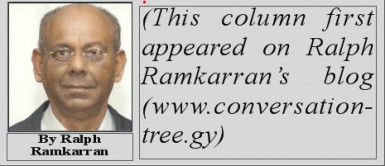 President Jagdeo came into office in 1999 intending to carve out a grand historical role for himself. He did not have the vision to see that such a role could best be achieved, not by seeking individual, ethnic glory, but through the elimination of ethno-political dominance by way of a government of national unity, which he would have headed. Instead, he offered a period of building trust and confidence during the process of constitutional reform taking place at that time, after which focus could be directed to national unity (Building Trust and Confidence – Towards Greater Inclusive Governance in Guyana, February 11, 2003). This of course was a hoax, merely designed to placate the diplomatic community, which had been bringing pressure on Jagdeo to make a gesture after the passing of Desmond Hoyte and the election of Robert Corbin as leader. As expected, the government did not follow up on this promise.
President Jagdeo came into office in 1999 intending to carve out a grand historical role for himself. He did not have the vision to see that such a role could best be achieved, not by seeking individual, ethnic glory, but through the elimination of ethno-political dominance by way of a government of national unity, which he would have headed. Instead, he offered a period of building trust and confidence during the process of constitutional reform taking place at that time, after which focus could be directed to national unity (Building Trust and Confidence – Towards Greater Inclusive Governance in Guyana, February 11, 2003). This of course was a hoax, merely designed to placate the diplomatic community, which had been bringing pressure on Jagdeo to make a gesture after the passing of Desmond Hoyte and the election of Robert Corbin as leader. As expected, the government did not follow up on this promise.
By 2011, so entrenched within the PPP was the culture of ethno-political dominance, that it was prepared to lose political office rather than act in its own interests and those of Guyana. When asked after the 2011 elections if he intended to invite the opposition into the government, President Ramotar, heading a minority government which was bound to fail said, “that will not happen.” President Ramotar could still have been president today had he allowed his vision to soar. And he could have served a second term as president heading a second national unity government.
It is to the credit of the APNU+AFC coalition that it has now taken such a monumental step of offering discussions. The internal pressures within the coalition, or specifically within APNU, against ending the culture of ethno-political dominance will loom large in the coming period. Thus it is necessary to launch a public campaign in support of talks for national unity. Such a full-blown public campaign should target and mobilize support from both the supporters of the coalition as well as from the PPP. Supportive public opinion will aid resistance to the coalition’s own opposing elements or those from the PPP.
In the meantime, while the PPP is united in its bitterness against Moses Nagamootoo and Khemraj Ramjattan, it may not have a united position in relation to the talks. In fact, the invitation to talks have not been rejected. The PPP’s refusal to sit down with Nagamootoo should not be an obstacle. There are creative ways around these matters.
Talks leading to a national unity government should be seen as a process, not an event. If the coalition wants to maintain focus on the larger picture, it will work through the sensitivities of the PPP. It will be prepared for the long haul and endure the painful negotiations but with purposeful commitment, serious compromises, the use of skilled interlocutors who are available within its own ranks and above all, persistence and patience. With each political party seeing the other as its nemesis, as its sole obstacle in its path to its rightful place at the top of the ladder of ethno-political dominance, a recipe already exists for failure. Statesmanship, vision and patience, if deployed, will succeed.
The size of the AFC’s team, which includes its leading members, Nagamootoo, Ramjattan and Trotman, suggests that the invitation might be an AFC initiative. If APNU is merely going along to humour its partner, the effort is doomed from the start.


